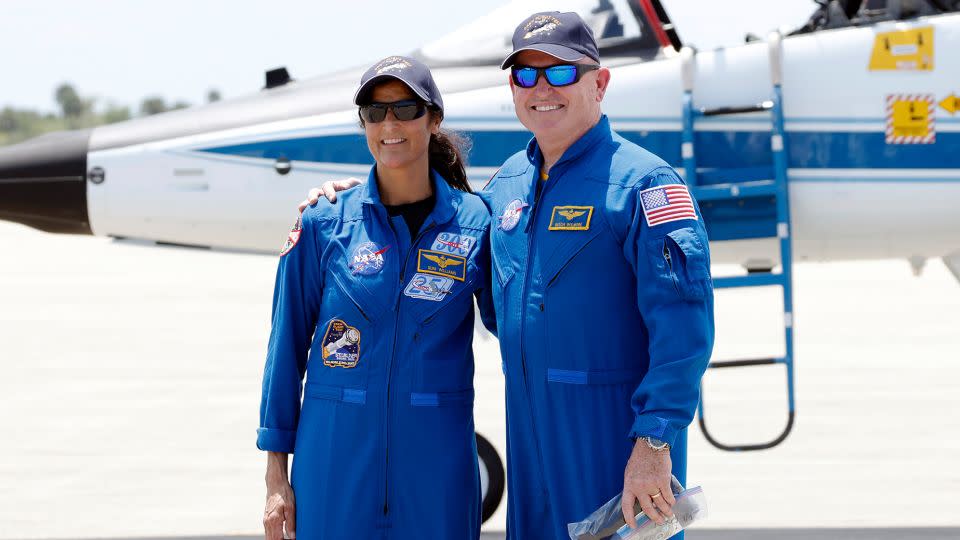Sign up for CNN’s Wonder Theory science newsletter. Explore the universe with news on exciting discoveries, scientific advances and more.
Boeing’s spaceflight program may reach a significant milestone Monday night with the launch of its Starliner spacecraft, carrying — ultimately — two NASA astronauts into orbit.
The mission, called the Crew Test Flight, could take off as early as Monday at 10:34 pm ET from the Cape Canaveral Space Force Station in Florida.
The event will be broadcast live on NASA channels starting at 6:30 pm ET on Monday, according to the space agency.
The event is a decade in the making — the culmination of Boeing’s efforts to develop a spacecraft capable of carrying astronauts to and from the International Space Station under NASA’s Commercial Crew Program.
Development bottlenecks, test flight problems and other costly obstacles have blocked Starliner’s path to the launch pad. Meanwhile, Boeing’s rival under NASA’s commercial crew program – SpaceX – has become the transport provider for the space agency’s astronauts.
Now, NASA and Boeing have finally deemed the Starliner spacecraft ready for its final test: allowing astronauts to test-drive the vehicle in outer space.
Veteran NASA astronauts Suni Williams and Butch Wilmore will be aboard the mission on Monday, riding Starliner to the International Space Station for a week.
During their flight, Wilmore and Williams will perform a series of tests, including briefly taking control of the autonomous spacecraft and assessing how the vehicle works for astronauts.
A smooth flight could be a triumphant moment for Boeing’s space flight program and for the company as a whole, which has been in the hot seat because of problems with its commercial airplane division.
Here’s what you need to know about Starliner’s journey ahead of its historic crewed test flight.
The human component
Officials at Boeing are trying to clarify that Starliner operates separately from the sector at the company responsible for commercial aircraft. And the Starliner team’s primary concern is ensuring a smooth test mission and crew safety, according to Mark Nappi, vice president and Starliner program manager at Boeing.
“We have people flying on this vehicle. We always take that seriously,” Nappi said during a news briefing last week. “I spent my career in this business, and it was always at the top of the list.”

The two Starliner astronauts have waited years for the spacecraft to be deemed ready to carry a crew. After several astronauts rotated in and out of assignments on the Starliner Crew Test Flight, Wilmore received her appointment in 2020. NASA moved Williams to this flight in 2022 after initially assigning her in 2018 to the later Starliner mission.
“We’ve sent a few dates, and we were like, ‘Okay, we’re ready to go,'” Williams said at a news conference Wednesday. “But now it’s like, heck – five days. It’s finally true, and I have to pinch myself a little bit to realize, really, we’re going.”
At a news briefing last month, Steve Stich, program manager of NASA’s Commercial Crew Program, said that NASA wanted Boeing and SpaceX to reach a certain threshold for the risk of astronaut deaths as a result of the mission – 1 in 270.
“Boeing exceeds that number with a crew loss of 1 in 295,” he said.
Starliner’s rocky path
Boeing received NASA’s contract to build Starliner in 2014 at the same time the space agency chose SpaceX to build its Crew Dragon capsule.
NASA has put together deals worth up to $6.8 billion, with Boeing and SpaceX hoping to have their capsules ready to fly as early as 2017.
That prospect did not pan out.
SpaceX took longer than planned, launching the first astronaut launch of its Crew Dragon capsule in the summer of 2020. It has since completed 13 missions into orbit for NASA astronauts and paying customers.
But Boeing — despite NASA officials initially believing the Starliner would be ready before SpaceX’s Crew Dragon — faced years of additional delays, obstacles and additional costs that cost the company more than $1 billion, according to public financial records.
In particular, the first Starliner test mission, flown unmanned in late 2019, was full of missteps. The vehicle orbited incorrectly, a sign of software orbit including a coding error that set the internal clock at 11 o’clock.
A second unmanned flight test in 2022 revealed additional software problems and trouble with some of the vehicle’s thrusters.
Those hang-ups delayed the first crewed flight into 2023. But a new slate of problems emerged — the spacecraft’s parachute had several components that were weaker than expected, and tape in the vehicle was found to be flammable.
Then Boeing had to remove more than a thousand worth of that tape and perform additional tests on the parachutes.
Finally, after ten years of development, NASA and Boeing have cleared the vehicle to fly astronauts.
‘Not everything will be perfect’
Williams and Wilmore took a measured approach when answering questions about the Starliner spacecraft development woes.
“I understand it when you say ‘setback,'” Wilmore said during the recent news conference. “But honestly, with all the discovery – that’s what we’d call it – that we’ve had, it’s a step forward.
“It wasn’t a stretch, he’s pushing on,” he said. “And our families lived that with us.”
Williams added that she is prepared to go into Monday’s mission in the expectation that minor issues may arise.
“We always find things, and we’re going to keep finding things,” she said Wednesday. “Not everything will be absolutely perfect when we fly the spacecraft. And that’s really what our goal is. We’ve gotten it—all of us, the big team—have gotten it to a point where we feel very safe and comfortable with how this spacecraft flies, and we have backup procedures just in case. that we will need those.”
“We’re here,” Williams said, “because we’re ready.”
For more CNN news and newsletters create an account at CNN.com